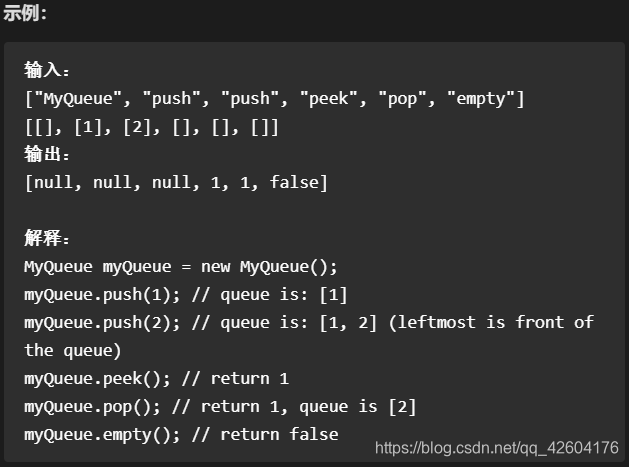題目
請你僅使用兩個棧實現先入先出隊列。隊列應當支持一般隊列的支持的所有操作(push、pop、peek、empty):
實現 MyQueue 類:
void push(int x) 將元素 x 推到隊列的末尾
int pop() 從隊列的開頭移除并返回元素
int peek() 返回隊列開頭的元素
boolean empty() 如果隊列為空,返回 true ;否則,返回 false
說明:
你只能使用標準的棧操作 —— 也就是只有 push to top, peek/pop from top, size, 和 is empty 操作是合法的。
你所使用的語言也許不支持棧。你可以使用 list 或者 deque(雙端隊列)來模擬一個棧,只要是標準的棧操作即可。
進階:
你能否實現每個操作均攤時間復雜度為 O(1) 的隊列?換句話說,執行 n 個操作的總時間復雜度為 O(n) ,即使其中一個操作可能花費較長時間。


參考別人思路,使用雙棧思想
push數據:把數據放進輸入棧
pop數據:
輸出棧如果為空,就把輸入棧數據全部導入,再從輸出棧彈出數據
如果輸出棧不為空,則直接從輸出棧彈出數據就可以了。
如何判斷隊列為空:如果輸入棧和輸出棧都為空,則說明模擬的隊列為空。
代碼
class MyQueue {
public:stack<int> stIn;stack<int> stOut;/** Initialize your data structure here. */MyQueue() {}/** Push element x to the back of queue. */void push(int x) {stIn.push(x);}/** Removes the element from in front of queue and returns that element. */int pop() {//如果輸出棧為空if(stOut.empty()){//就把數據全部導入while(!stIn.empty()){stOut.push(stIn.top());stIn.pop();}}//從輸出棧彈出數據int result =stOut.top();stOut.pop();return result;}/** Get the front element. */int peek() {//直接使用已有pop函數int res = this->pop();//因為pop()函數彈出了元素res,所以還得再添加回去stOut.push(res);return res;}/** Returns whether the queue is empty. */bool empty() {return stIn.empty() && stOut.empty();}
};/*** Your MyQueue object will be instantiated and called as such:* MyQueue* obj = new MyQueue();* obj->push(x);* int param_2 = obj->pop();* int param_3 = obj->peek();* bool param_4 = obj->empty();*/






)




)







